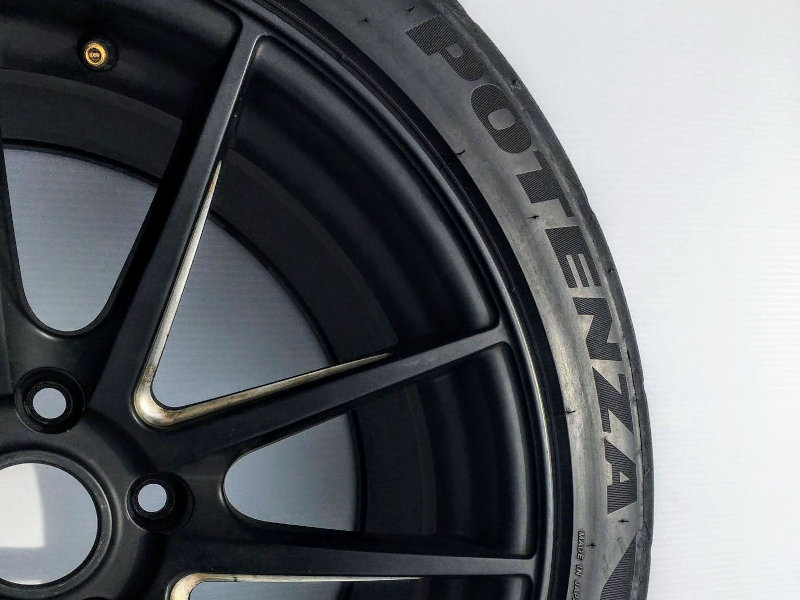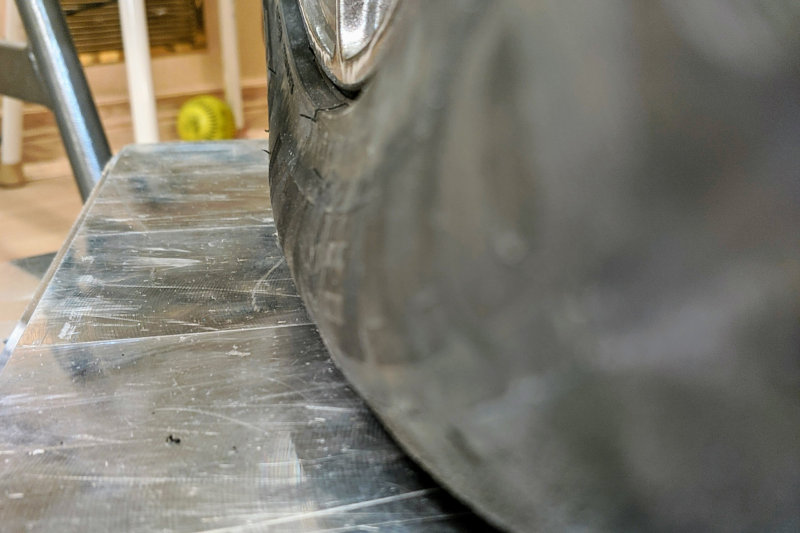Measuring the tire vertical stiffness of a 255/40R17 ultra-high performance 200TW tire - Bridgestone Potenza RE-71R

Managing the relationship between the tire and the vehicle is an important element of vehicle handling. The tire is the vehicle’s interface with the road and must work with the suspension system to support the vehicle weight.
The tire vertical stiffness is a property that can be helpful in evaluating tire performance. While it is not an indicator of its grip capabilities, it will affect the vertical dynamics of the vehicle. To demonstrate the applicability of this property, we take a popular 200TW ultra-high performance tire and measure its vertical stiffness. This tire is the Bridgestone Potenza RE-71R 255/40R17 98W.
Tire load-deflection
The tire is an elastic element that acts in series with the springs to modify the overall ride rate of the vehicle. Just like an ordinary coil spring, the tire vertical stiffness can be computed from a load-deflection curve.
Tire load-deflection curves are obtained by exercising the tire through a range of vertical loads. The tire is compressed into a flat plate where the tire vertical load and radial deflection are measured. The tangent of the load-deflection curve at a specific point is the tire vertical stiffness.
\[K_{Z} = \frac{dF_Z(R_l)}{dR_l} \Bigg|_{F_{Z}=x}\]Where:
- \(K_Z\) is the tire vertical stiffness [N/mm]
- \(F_Z\) is the tire vertical load [N]
- \(R_l\) is the tire loaded radius [mm]
- \(x\) is the tire vertical load where the vertical stiffness is evaluated [N]
Testing was performed by Formula Delta using their tire vertical stiffness testing fixture. The tire vertical stiffness testing capabilities of the Formula Delta tester are shown in the table below.
| Parameter | Value |
|---|---|
| Vertical load, max [N] | 6675 |
| Loaded radius, max [mm] | 375 |
| Tire width, max [mm] | 400 |
| Inclination angle [deg] | 0, 2, 4 |
| Bolt pattern | 5x114 |
Test schedule

The tire under test is a used Bridgestone Potenza RE-71R 255/40R17 98W. Released in North America in 2015, the Bridgestone Potenza RE-71R is a popular choice for enthusiasts in the ultra-high performance tire segment. This makes it a good representation of a typical 200TW tire.
Testing is performed in a temperature controlled environment. The test conditions are summarized in the table below.
| Parameter | Conditions |
|---|---|
| Ambient temperature [degC] | 17 |
| Tread depth [mm] | 4.5 |
| Vertical load, max [N] | 6230 |
| Inflation pressure [PSI] | 24, 27, 30, 33, 36 |
| Inclination angle [deg] | 0, 2, 4 |
Measurements are taken during both loading and unloading conditions. The data is fit to a second degree polynomial using least-squares regression. Values are referenced using the SAE tire coordinate system.
Analysis
We start the analysis by looking directly at the measured tire load-deflection curves. The figure below shows the load-deflection curves across all test conditions and includes a composite curve showing the average response.
We can already observe the influence of inflation pressure and inclination angle just by inspecting the load-displacement curves. The change in unloaded radius due to the inclination angle is primarily an artifact of the SAE tire coordinate system. However, between inclination angles you can see how the unloaded radius grows with inflation pressure. With vertical load, there is even more variation between the conditions.
The tire vertical stiffness can be computed from the load-displacement curves at a specific vertical load. We have chosen a reference vertical load of 3560 N to measure the vertical stiffness. The results of the analysis are shown in the figure below. For reference, the tire vertical stiffness measured from the composite load-displacement curve is 252.1 N/mm.
The influence of inflation pressure and inclination angle on vertical stiffness is more apparent in this analysis. As the inflation pressure increases, the tire vertical stiffness increases. This relationship is observed across all inclination angles. Increasing the inclination angle from 0 deg to 2 deg decreases the vertical stiffness by 5.5% on average. However, increasing the inclination angle from 2 deg to 4 deg does not have the same effect. On average, the vertical stiffness is reduced by 1%, with only the 33 PSI condition showing an increase in vertical stiffness.
Final comments
In this study, we measured the vertical stiffness of the Bridgestone Potenza RE-71R 255/40R17 98W tire under different inflation pressure and inclination angle conditions. We found that the vertical stiffness at 3560 N can vary from 215.6 N/mm to 292.7 N/mm depending on the conditions. The influence of inflation pressure on vertical stiffness is observed at all inclination angles. It is less clear how inclination angle affects the tire vertical stiffness. At reference load, there is an overall reduction of ~5.5% in tire vertical stiffness when the inclination angle goes from 0 deg to 2 deg. However, increasing the inclination angle from 2 deg to 4 deg did not have the same effect.
The tire is an elastic springing element in the suspension system that cannot be ignored. Understanding the relationship between the tires and the chassis affords you better tuning control over the ride and the lateral load transfer distribution. With manufacturers being opaque with the technical data of their products, laboratory tire tests represent one way to gain insight into tire performance. The vertical stiffness test can be repeated with several tires to provide insight into how tire manufacturers are differentiating their products, especially in today’s competitive enthusiast tire market.
Acknowledgements
This analysis is possible thanks to Ping Zhang at Formula Delta. This analysis required considerable amount of design, manufacturing and testing support. You can learn more about Formula Delta on Facebook and Instagram!
References
- Gent, A. N., & Walter, J. D. (2006). Pneumatic tire.
- Milliken, William F., and Douglas L. Milliken. Race car vehicle dynamics. Vol. 400. Warrendale: Society of Automotive Engineers, 1995.